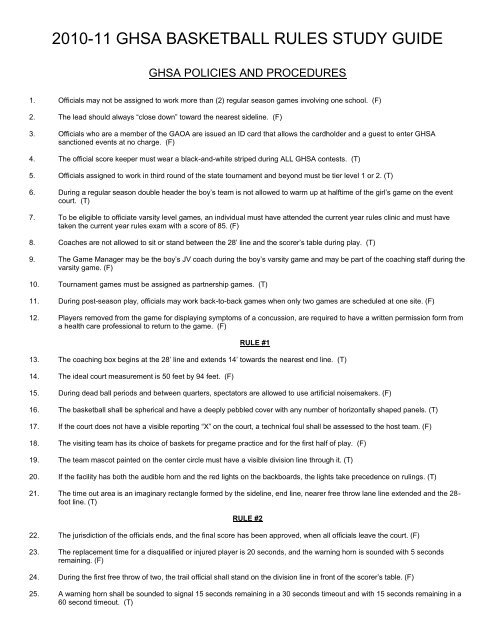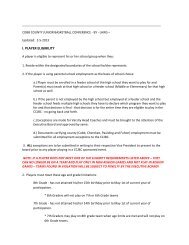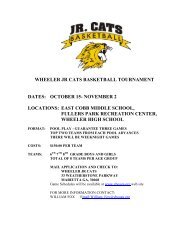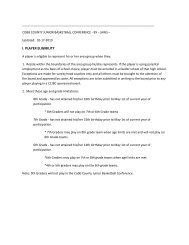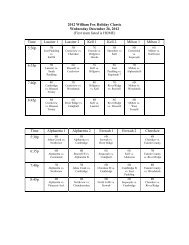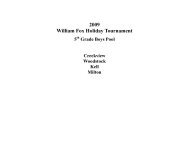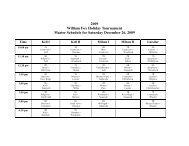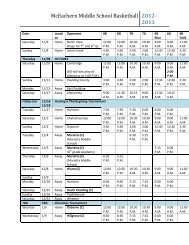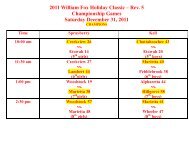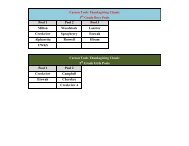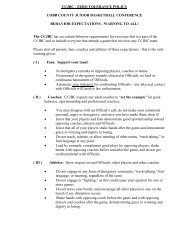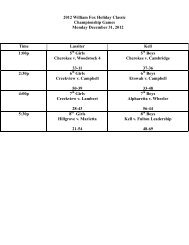2010-11 ghsa basketball rules study guide - ccjbc
2010-11 ghsa basketball rules study guide - ccjbc
2010-11 ghsa basketball rules study guide - ccjbc
- No tags were found...
You also want an ePaper? Increase the reach of your titles
YUMPU automatically turns print PDFs into web optimized ePapers that Google loves.
<strong>2010</strong>-<strong>11</strong> GHSA BASKETBALL RULES STUDY GUIDEGHSA POLICIES AND PROCEDURES1. Officials may not be assigned to work more than (2) regular season games involving one school. (F)2. The lead should always “close down” toward the nearest sideline. (F)3. Officials who are a member of the GAOA are issued an ID card that allows the cardholder and a guest to enter GHSAsanctioned events at no charge. (F)4. The official score keeper must wear a black-and-white striped during ALL GHSA contests. (T)5. Officials assigned to work in third round of the state tournament and beyond must be tier level 1 or 2. (T)6. During a regular season double header the boy’s team is not allowed to warm up at halftime of the girl’s game on the eventcourt. (T)7. To be eligible to officiate varsity level games, an individual must have attended the current year <strong>rules</strong> clinic and must havetaken the current year <strong>rules</strong> exam with a score of 85. (F)8. Coaches are not allowed to sit or stand between the 28’ line and the scorer’s table during play. (T)9. The Game Manager may be the boy’s JV coach during the boy’s varsity game and may be part of the coaching staff during thevarsity game. (F)10. Tournament games must be assigned as partnership games. (T)<strong>11</strong>. During post-season play, officials may work back-to-back games when only two games are scheduled at one site. (F)12. Players removed from the game for displaying symptoms of a concussion, are required to have a written permission form froma health care professional to return to the game. (F)RULE #<strong>11</strong>3. The coaching box begins at the 28’ line and extends 14’ towards the nearest end line. (T)14. The ideal court measurement is 50 feet by 94 feet. (F)15. During dead ball periods and between quarters, spectators are allowed to use artificial noisemakers. (F)16. The <strong>basketball</strong> shall be spherical and have a deeply pebbled cover with any number of horizontally shaped panels. (T)17. If the court does not have a visible reporting “X” on the court, a technical foul shall be assessed to the host team. (F)18. The visiting team has its choice of baskets for pregame practice and for the first half of play. (F)19. The team mascot painted on the center circle must have a visible division line through it. (T)20. If the facility has both the audible horn and the red lights on the backboards, the lights take precedence on rulings. (T)21. The time out area is an imaginary rectangle formed by the sideline, end line, nearer free throw lane line extended and the 28-foot line. (T)RULE #222. The jurisdiction of the officials ends, and the final score has been approved, when all officials leave the court. (F)23. The replacement time for a disqualified or injured player is 20 seconds, and the warning horn is sounded with 5 secondsremaining. (F)24. During the first free throw of two, the trail official shall stand on the division line in front of the scorer’s table. (F)25. A warning horn shall be sounded to signal 15 seconds remaining in a 30 seconds timeout and with 15 seconds remaining in a60 second timeout. (T)
26. The official scorebook shall remain at the scorer’s table at all times until the game has been completed. (T)27. The officials can only correct a bookkeeping mistake if it is recognized prior to the first dead ball after the mistake. (F)28. The referee may designate any official to toss the ball to start the game. (T)29. If the game is stopped for a bleeding player, the officials will allow the player to remain in the game if either team calls a timeout at that point. (F)30. Officials should always make call in their primary coverage area and not reach into a secondary area. (F)31. If a correctable error involves a free throw by the wrong player, the free throw and all activity during it shall be canceled. (T)RULE #332. Headbands must match the predominant color of the jersey, or be white, black, or beige. (F)33. Protective faceguards must be form fitting to the face to be legal for play. (T)34. Any hair control device that goes around the entire head is considered a headband and must adhere to the headbandstandards. (T)35. Ponytail holders do not have to adhere to the same standards of headbands and hair control devices, but may not be ribbonsor have hard objects attached to them. (T)36. No less than 10 minutes prior to the start of the game, each team shall submit the name, number, and indicate the five startersto the official score keeper. (T)37. A1 has a bobby pin in her hair. If this is discovered before the opening tip to start the game the player is asked to remove thepin, if the player disregards the request a technical foul shall be called. (F)38. A player, who has been replaced, may not re-enter the game until the next opportunity to substitute after the clock has beenproperly started. (T)39. If a player’s shirt is not properly tucked inside the pants, the official shall direct him or her to leave the game immediately. (F)40. If a coach, or medical personnel, is beckoned onto the court to tend to an injured player, the player shall be directed to leavethe game. (T)41. A visible manufactures logo is permitted on a legal undergarment. (F)42. Following the end of a period, substitutes must check-in in prior to the sounding of the warning horn to resume play for thesubsequent period. (T)43. Only one visible logo or school mascot is allowed on headbands and/or wristbands. (T)RULE #444. When a time out is not permitted by rule, the player’s request shall be ignored. (T)45. At any time a player makes contact with the ball, while any part of the ball is within the imaginary cylinder, “goal tending”should be called. (F)46. Team control is lost at any time when a player loses player control of the ball. (F)47. A disqualified player becomes bench personnel when an official has notified the head coach of the disqualification. (T)48. Pivot foot restrictions are in effect during a throw in. (F)49. During a live ball status, a hard contact foul should be called a “technical foul”. (F)50. At any time the ball strikes any part of the leg or foot, a kicking violation shall be called. (F)51. A closely guarded count is terminated when the offensive player gets his/her head and shoulders past the defender. (T)52. Goaltending occurs when a moveable ring is pulled down so that it contacts the ball before returning to its original position. (F)
53. To establish legal screening position, the screener may be facing any direction and time and distance are not relevant as longas the screener is stationary. (F)RULE #554. When a player control foul is called, the goal is cancelled regardless of whether the foul occurred before or after the ballentered the basket. (T)55. Team A is considered to have team control during a throw in by A1. (F)56. During a throw-in, if less than .5 of a second remain on the game clock, a try can only be counted on a tap. (F)57. A timeout will be cut short if the calling team chooses to enter the court prior to the warning signal. (F)58. On-court entertainment shall not occur during a 30-second timeout. (T)59. When one team is trailing by 30 points or more at the end of the third quarter, the referee shall inform both coaches that the“mercy rule” will be enacted at the beginning of the 4 th quarter. (T)60. A1 attempts a field goal near the end of the period and the lead official calls a foul and the horn sounds. The officials shouldplace the shooter on the free throw line with zeros on the clock and no one else on the lane lines. (F)61. Officials must be aware of time left on the clock when fouls occur near the end of periods. (T)62. If a technical foul is called after the ball has become dead to end a quarter, the penalty will be administered to start thesubsequent quarter/overtime period. (T)63. The referee may correct obvious timing errors made with regard to starting or stopping the clock. (T)RULE #664. During a jump ball, the ball becomes live when it is legally touched by one of the jumpers. (F)65. Until the ball is touched by one or both of the jumpers, non-jumpers are not allowed to move into or away from the plane of therestraining circle. (F)66. When a live ball becomes lodged between the backboard and the ring, play shall be resumed by virtue of the alternatingpossession arrow. (T)67. The alternating possession arrow is reset when a throw-in touches a player inbounds or the throw-in team commits a violationduring an alternating possession throw-in. (T)68. If the offensive team fouls during an alternating possession throw-in, the alternating possession arrow will be reversed. (F)69. The ball becomes dead immediately when either team violates during free throw administration. (F)70. The ball does not become dead during a continuous motion foul until the result of the try is determined. (T)71. During a jump ball, both jumpers must attempt to touch the ball thrown by the referee. (F)72. During a throw-in, the ball becomes live when it is touched by another player on the court. (F)73. Following a successful field goal or free throw, the thrower is allowed to run with the ball but may not dribble the ball outsidethe end line. (F)RULE #774. When a ball goes out of bounds after being touched simultaneously by two opponents, an alternating possession throw-in willoccur nearest the spot when the ball went out of bounds. (T)75. The game is tied at the end of regulation time. After the toss to start the overtime period, the timer blows the horn to inform theofficials that the score was actually not tied. At that time, the game shall end with the team leading at the end of regulationwinning. (F)76. Following the jump ball, and prior to the alternating possession being determined, any two opposing players may be involvedin the subsequent jump when a held ball occurs. (F)77. After the awarded free throws have been completed following an intentional foul, play shall be resumed with a throw-in at thedivision line.
RULE #878. During free throw administration for an intentional foul, the lane spaces shall remain vacant. (T)79. During free throw administration, the maximum number of teammates of the thrower allowed in lane spaces is two. (T)80. During free throw administration, if both personal and technical fouls occur they will be administered in the order in which theyoccurred unless one of the fouls is a multiple foul. (F)81. If a player is unable to attempt awarded free throws due to an injury, the opposing coach may select the substitute to attemptthe free throws. (F)82. Free throws awarded due to a technical foul may be attempted by an eligible substitute designated by the head coach. (T)RULE #983. If the dribbler is not in contact with the ball when he/she steps on the boundary line, no violation occurs. (F)84. During a throw-in following a made free throw, the ball may be passed to a teammate of the thrower who is standing out-ofboundsalong the end line. (T)85. During a closely guarded situation involving a trap by two defenders, the 5-second count should end if one of the defensiveplayers leaves the double team. (F)86. It is a violation if A1 dives for a loose ball, gains control on the floor, then slides a considerable distance with the ball. (F)87. Jumpers A1 and B1 commit jump ball violations at the same time. The toss shall be repeated. (T)88. A technical foul shall be called when, after securing a rebound, B-1 comes to the floor and excessively swings his/her elbows.(F)89. A violation shall be called if a player inadvertently slaps the backboard during an attempt to block a shot (F).90. A violation shall be called, and the goal awarded, if a player intentionally slaps the backboard in an attempt to affect a ball onthe cylinder. (T)RULE # 1091. During post-season games, the home team may wear either white or light jerseys. (F)92. During a dunk attempt by A-1, B1 places one hand in the back of A1 while airborne. This is always an intentional foul and maybe ruled flagrant with regard to the severity of the contact. (T)93. A technical foul shall be assessed for a subsequent violation of any of the delay of game violations. (T)94. A disqualified player is permitted to remove his/her jersey after being notified of the fifth foul by the official. (F)95. B1 stumbles over the legs of A1, who has fallen to the court. A foul shall be called on A1 because he is not in a legal guardingposition. (T)96. A technical foul shall be assessed to a coach or player who attempts to incite undesirable crowd reactions. (T)97. A defensive player is allowed to place a forearm/hand on the dribbler as long as the arm is not extended. (F)98. All three officials should start the clock on a throw in. (F)99. Bouncing the ball to the thrower is recommended when administering a throw-in on the sideline. (T)100. During an interrupted dribble either team may be granted a timeout. (F)


